|
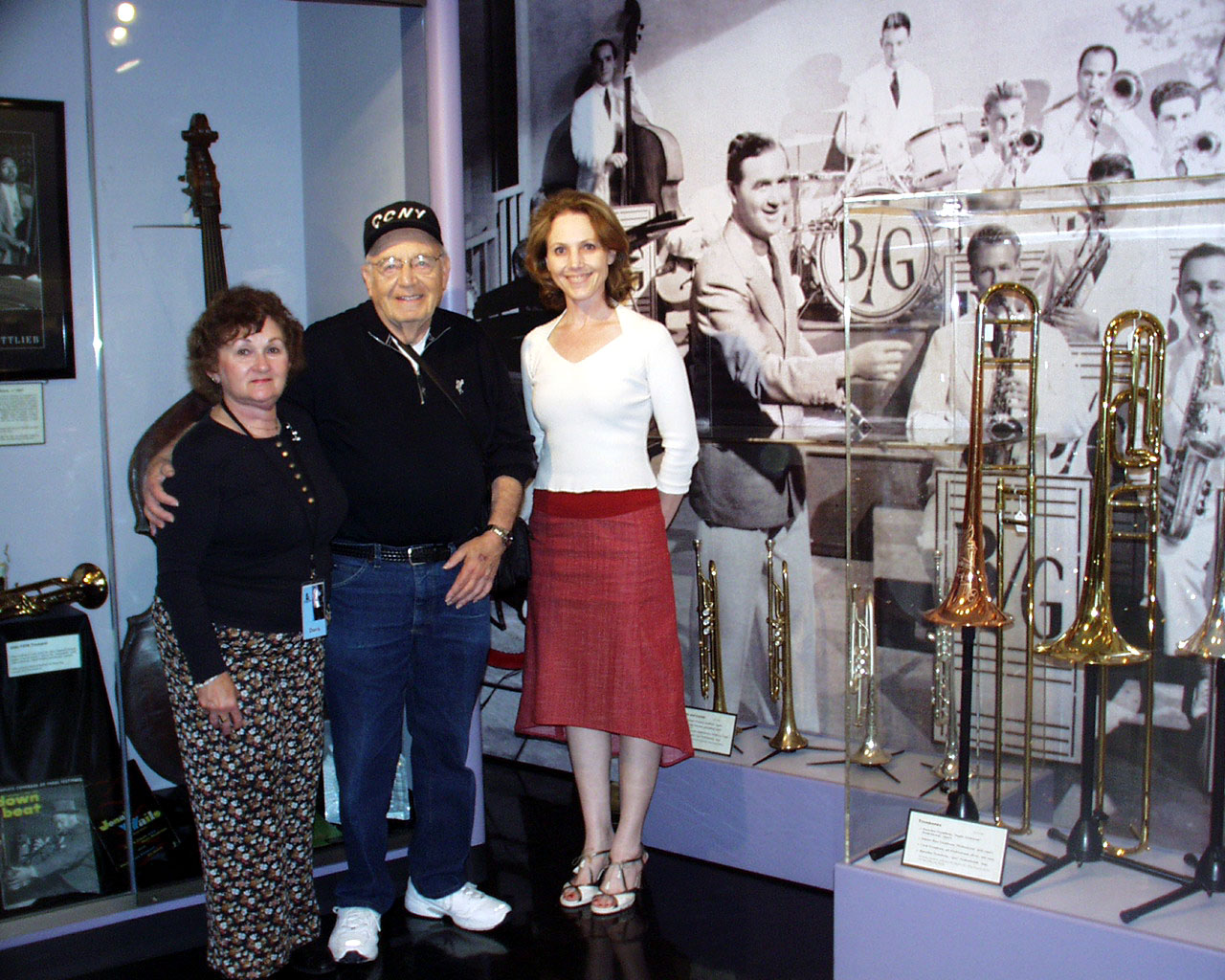
BENNY GOODMAN AND FRIENDS—Bandleader Benny Goodman seems to
be standing over the left shoulder of Carolyn Grant, executive director of the
Museum of Making Music, as she stands with docents Doris Teich and Gerry Greber.
The large photo was taken from the 1942 movie, The Powers Girl, one of
many in which the swing band appeared.
By Donald H. Harrison
CARLSBAD, Calif.—Jewish accomplishment is well represented in the music
industry's own museum celebrating a century of American musical performers,
technology and marketing.
The Museum of Making Music is located in a complex of buildings that look west
across the famous flower fields of this city in northern San Diego County to the
Pacific Ocean beyond. In a succession of galleries, each covering two
decades, the museum created by the National Association of Music Manufacturers (NAMM)
shows the musical instruments of each era, provides sound bites of famous
artists, and discusses how various companies advertised and sold their products
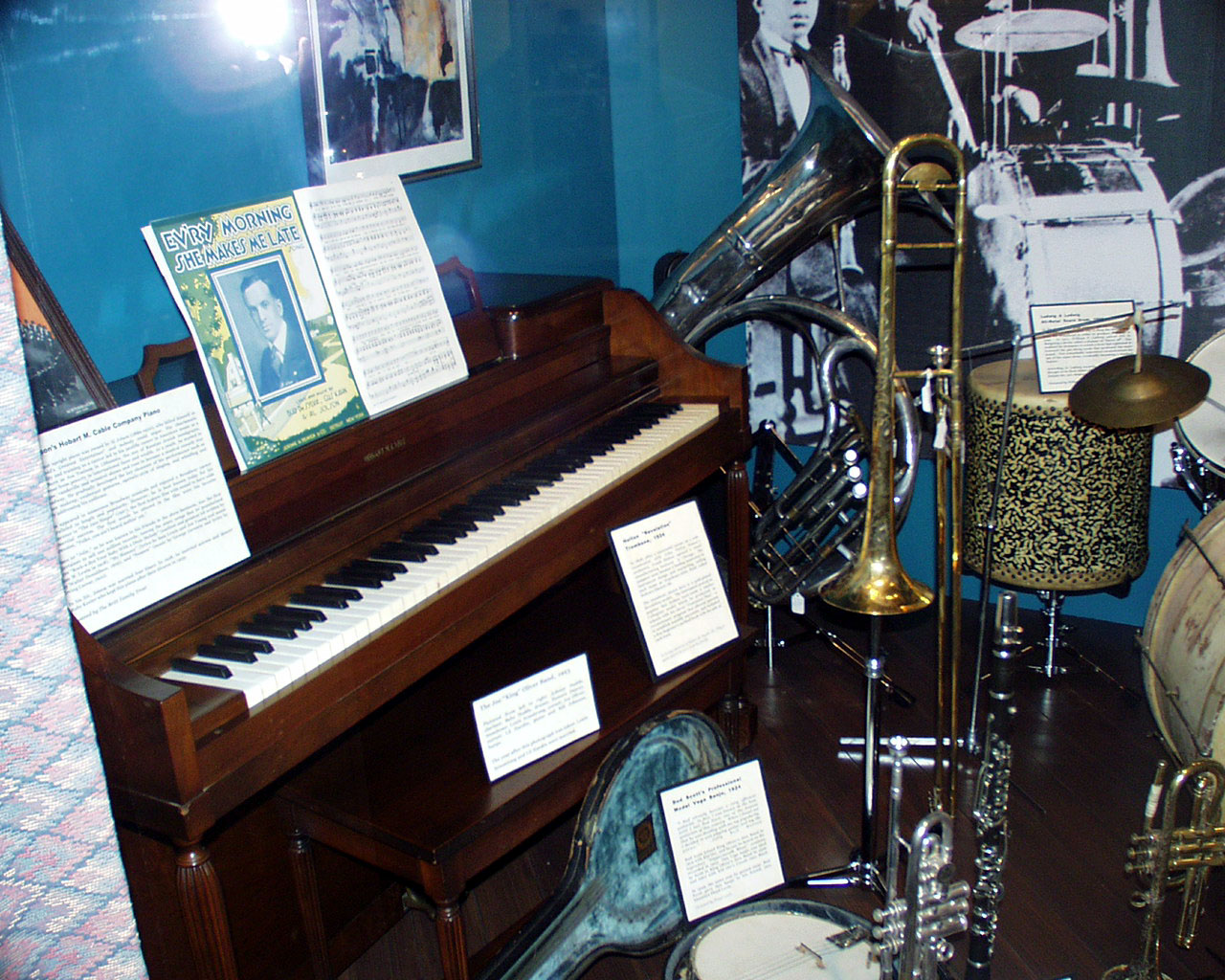 Music,
of course, is a universal expression of mankind, to which all ethnic groups have
contributed. But within that broader context, one can pick out here and
there the names of Jews who made major contributions. For example, a visitor
finds that Al Jolson owned, until actress Ruby Keeler divorced him in 1939, an upright piano grouped with other instruments in the museum's
collection. A placard near the piano describes the performer: Music,
of course, is a universal expression of mankind, to which all ethnic groups have
contributed. But within that broader context, one can pick out here and
there the names of Jews who made major contributions. For example, a visitor
finds that Al Jolson owned, until actress Ruby Keeler divorced him in 1939, an upright piano grouped with other instruments in the museum's
collection. A placard near the piano describes the performer:
...His charismatic personality and training as a cantor led to
the prolific career in American music as a singer. Born as Asa Yoelson in
Lithuania, the son of Russian Jewish immigrants, Jolson rose from poverty to
international fame and wealth. As a youth he started in burlesque, vaudeville
and minstrel shows and rose to become a musical comedy star on Broadway.
He gradually developed the key elements of his performance, such as blackface
makeup, exuberant gestures, operatic style of singing and whistling, and
directly addressing his audience. Jolson appeared in numerous Broadway
musicals and enjoyed a Broadway career unparalleled in length and popularity.
However he is best known for his appearance in the Jazz Singer, the first
feature film with sound that had wide commercial success. The first words
he uttered in the film were his favorite expression, "Folks you ain't heard
nothin' yet." Jolson, or Jolie, as he was known to his friends in
show business, was the first entertainer to sell one million records.
Among the many songs he popularized were Rock-A-bye Your Baby With A Dixie
Melody, which was written by Sam M. Lewis, in 1918, My Mammy by Sam
Lewis and Joe Young, lyrics, and music by Walter Donaldson, 1929, and Swanee,
music by George Gershwin and lyrics by Irving Caesar, 1921....
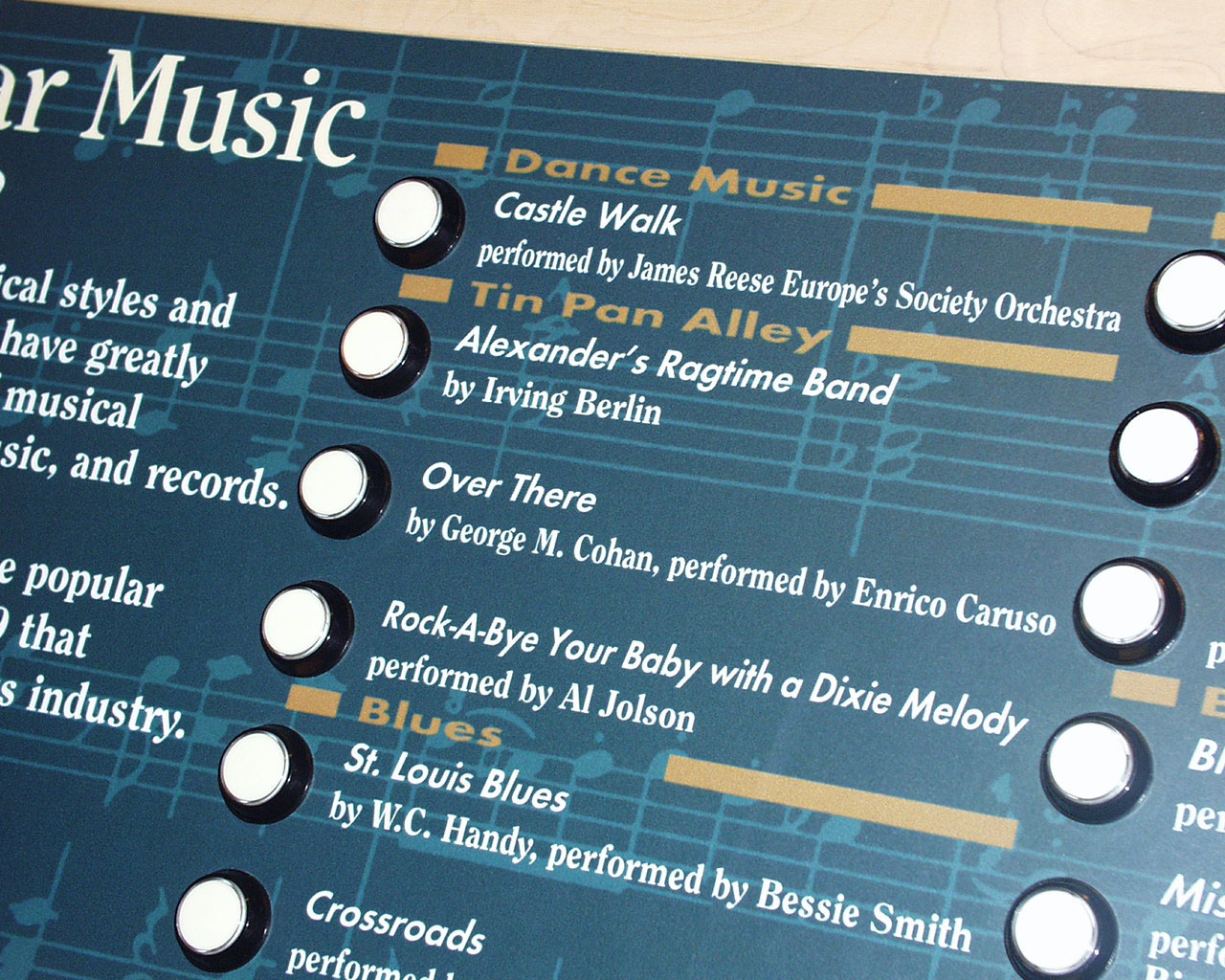 Located
near the piano is an interactive display featuring music that was popular in
Jolson's era. Jewish performers and composers seem to dominate the
"rag time music," category with museum visitors able to choose such
selections as Jolson singing Rock-A-Bye Your Baby With A Dixie Melody
or Irving Berlin performing Alexander's Ragtime Band. Oh, in case
you're wondering, Cohan as in George M. Cohan, who composed the World War I
standard, Over There, is an Irish name, not a Jewish one. Located
near the piano is an interactive display featuring music that was popular in
Jolson's era. Jewish performers and composers seem to dominate the
"rag time music," category with museum visitors able to choose such
selections as Jolson singing Rock-A-Bye Your Baby With A Dixie Melody
or Irving Berlin performing Alexander's Ragtime Band. Oh, in case
you're wondering, Cohan as in George M. Cohan, who composed the World War I
standard, Over There, is an Irish name, not a Jewish one.
Gershwin, whom we first encounter as the composer of Swanee sung by
Jolson, is found in a more serious vein in an exhibit dealing with the
technological innovations in music between the years of 1910 and 1929. One
of the innovations on display is a "reproducing piano," or as some
call it, a "player piano." One of the selections featured on
this instrument is Gershwin's Rhapsody in Blue.
Another Jewish contribution in this period came in the field of technology,
specifically in the development of microphones used in recording studios.
Here is how the museum explains this advance in the field of broadcast:
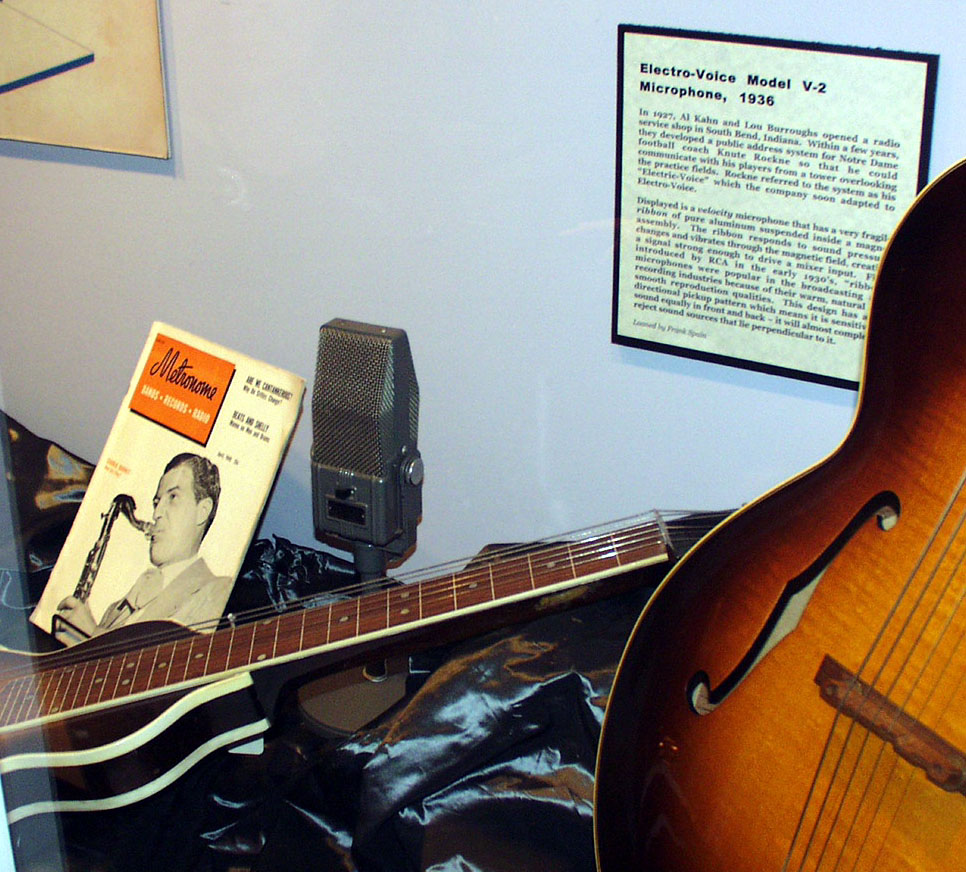 Electro-Voice
Model V2 Microphone —In 1927 Al Kahn and Lew Burroughs opened a radio
service shop in South Bend, Indiana, and within a few years they developed a
public address system for Notre Dame football coach Knute Rockne so he could
communicate with his players from a tower overlooking the practice fields.
Rockne referred to the system as his electric-voice, which the company soon
adapted to electro-voice. Displayed is a velocity microphone that has a very
fragile ribbon of pure aluminum suspended inside a magnet assembly. The ribbon
responds to sound pressure changes and vibrates through the magnetic filed
creating a signal strong enough to drive a mixer input. First introduced by
RCA in the early 1930s ribbon microphones were popular in the broadcasting and
recording industries because of their warm, natural and smooth reproduction
qualities. This design has a bi-directional pick up pattern which means it is
sensitive to sound equally in front and back and it will almost completely
reject sound sources that lie perpendicular to it.... Electro-Voice
Model V2 Microphone —In 1927 Al Kahn and Lew Burroughs opened a radio
service shop in South Bend, Indiana, and within a few years they developed a
public address system for Notre Dame football coach Knute Rockne so he could
communicate with his players from a tower overlooking the practice fields.
Rockne referred to the system as his electric-voice, which the company soon
adapted to electro-voice. Displayed is a velocity microphone that has a very
fragile ribbon of pure aluminum suspended inside a magnet assembly. The ribbon
responds to sound pressure changes and vibrates through the magnetic filed
creating a signal strong enough to drive a mixer input. First introduced by
RCA in the early 1930s ribbon microphones were popular in the broadcasting and
recording industries because of their warm, natural and smooth reproduction
qualities. This design has a bi-directional pick up pattern which means it is
sensitive to sound equally in front and back and it will almost completely
reject sound sources that lie perpendicular to it....
Coincidentally, an album cover bearing the image of jazz saxophonist Stan Getz
is found in the same exhibit case. As this particular exhibit focuses on
technology, a panel talks about the technology of the record album on which
the Jewish musican's performance is reproduced.
The typical 10 inch 78s that most Americans were
familiar with up to the late 1940s were brittle and easily broken, however
this changed in a revolutionary way when Columbia began pressing 10 inch and
12 inch microgroove 33 1/3 rpm LPs or long playing records in 1948. The new
vinyl LPs were made from a type of multipurpose thermal plastic developed by
the oil industry and called polyvinyl chloride. Because of its flow
characteristics, records made from vinyl have less surface noise and are more
flexible that the shellac-based 78s. The following year RCA countered with
their 7 inch microgroove 45 rpm EP, or extended play records, in the
hope that consumers would prefer the same amount of recorded material per disk
as on the traditional 78s but in a lighter more compact higher fidelity
format. Both companies promoted their formats heavily but eventually
Columbia 33 1/3 LPs became the industry standard...
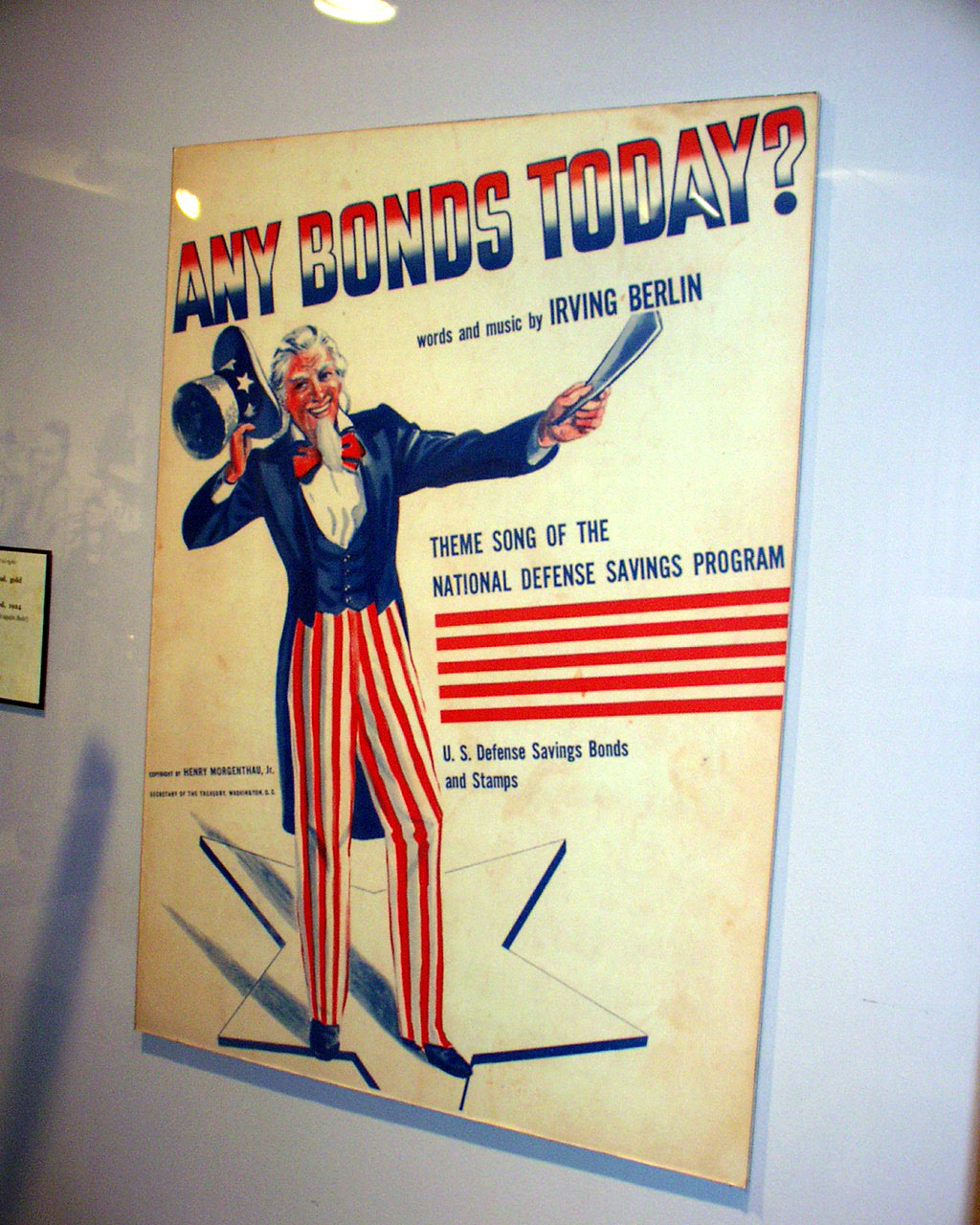 On
the interactive display board, Goodman's King Porter Stomp is a
listening choice. Another, demonstrating the wide ranging interests of
Jewish composers, is an Irving Berlin song popularized by Bing Crosby.
You guessed it: White Christmas. Berlin is not the only Jew
whose name is associated with Christmas music. There is also on
display a Dinah Shore record album, obviously issued for the holidays.
Among Shore's selections: Jingle Bells, Silent Night and Santa
Claus. Berlin's music also was used in an album promoting the sale
of U.S. Savings Bonds during World War II On
the interactive display board, Goodman's King Porter Stomp is a
listening choice. Another, demonstrating the wide ranging interests of
Jewish composers, is an Irving Berlin song popularized by Bing Crosby.
You guessed it: White Christmas. Berlin is not the only Jew
whose name is associated with Christmas music. There is also on
display a Dinah Shore record album, obviously issued for the holidays.
Among Shore's selections: Jingle Bells, Silent Night and Santa
Claus. Berlin's music also was used in an album promoting the sale
of U.S. Savings Bonds during World War II
The "Big Band" era of the 1940s was illustrated
with a mural of Benny Goodman's band performing in the movie The Powers
Girl, which starred a song and dance man who later was elected as a United
States senator from California—George Murphy.
The mural identifies some of the musicians who performed regularly with
Goodman, including Jimmy Rowles, piano; Cliff Hill, bass; Dave Barbour,
guitar; Hud Davies, drums; Charlie Castaldo and Lou McGarrity, trombones;
Lawrence Stearns, Jimmy Maxwell, and Tony Faso, trumpets; Clint Neagley
and Hymie Schertzer, alto sax; Jon Walton and Al Kline, tenor sax, and Bob
Poland, baritone sax.
As one moves through the gallery of the 1940s and 1950s, one
also learns of some of the changes in the marketing of music. An enlarged 1949
quotation from Henry S. Grossman, president of the National Association of
Music Merchandise Wholesalers, reported that "several years ago a
prominent manufacturer of band instruments sent a questionnaire to all his
dealers to (see) if they would (also) buy supplies and accessories from him in
preference to the jobber . The vote was greatly in preference for the
wholesaler because of single package economy.... "
Carolyn Grant, executive director of the museum that was opened to the public
six years ago, says the next gallery—that of the music of the 1960s and 1970s—is her
favorite, perhaps because she was born in 1960, so the music of that era
"formed my character." Depending on their ages, other of the
museum's approximately 20,000 annual visitors gravitate to other galleries.
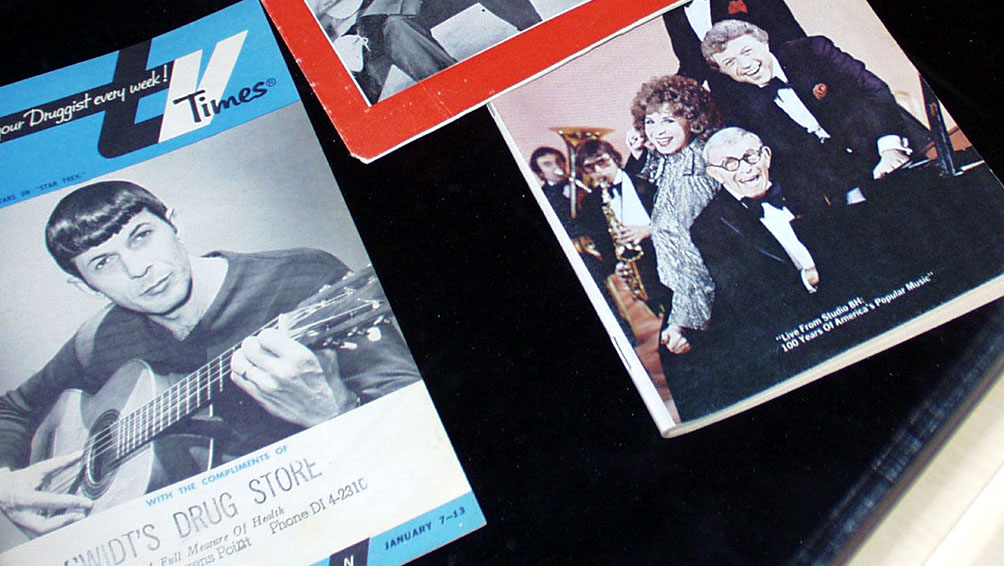 The
1960s-1970s gallery is introduced with a large poster of Who Else?—Elvis Presley—but
also includes other icons of the era including the Beatles. Helping me search
for our in-common "Jewish connection," docents Doris Teich and Gerry Greber
found in a display case one television guide picturing George Burns, Steve
Lawrence and Edie Gorme together at a piano and another showing Leonard Nimoy,
then at the height of his popularity as Star Trek's Dr. Spock, playing a
guitar. The
1960s-1970s gallery is introduced with a large poster of Who Else?—Elvis Presley—but
also includes other icons of the era including the Beatles. Helping me search
for our in-common "Jewish connection," docents Doris Teich and Gerry Greber
found in a display case one television guide picturing George Burns, Steve
Lawrence and Edie Gorme together at a piano and another showing Leonard Nimoy,
then at the height of his popularity as Star Trek's Dr. Spock, playing a
guitar.
Numerous record covers also were featured in this gallery, with
Bob Dylan (Robert Zimmerman) among the artists represented. The Byrds was another group of the era, whose music can be played by pushing a
button on an interactive exhibit. The selection, Turn, Turn, Turn, had
a decided Jewish angle: its lyrics are drawn straight from the biblical book
of Ecclesiastes.
Grant, who majored in piano performance at the University of Arizona, before
becoming an educator and museum administrator, said initially the Museum of
Making Music was created by NAMM, which has its offices upstairs, for the use
of its own members. Subsequently the national association decided to share the museum's
resources with the general public. The museum's mission, she said,
"is to celebrate the rich history and encourage the future of music
making."
The executive director said other museums "are either
halls of fame, or they are celebrity instrument based, or they are purely
instrument based, or they are genre based— such as a jazz museum,
blues museum, etcetera. We are the only museum that really takes all of those different aspects
and focuses on the act of music making — what goes into the design of an
instrument, what goes into getting these instruments into the hands of players
, and then tying everything from the idea to the making, to the distribution,
to the performing,..."
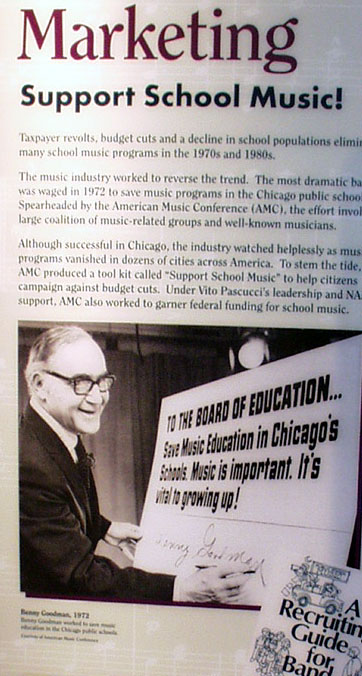 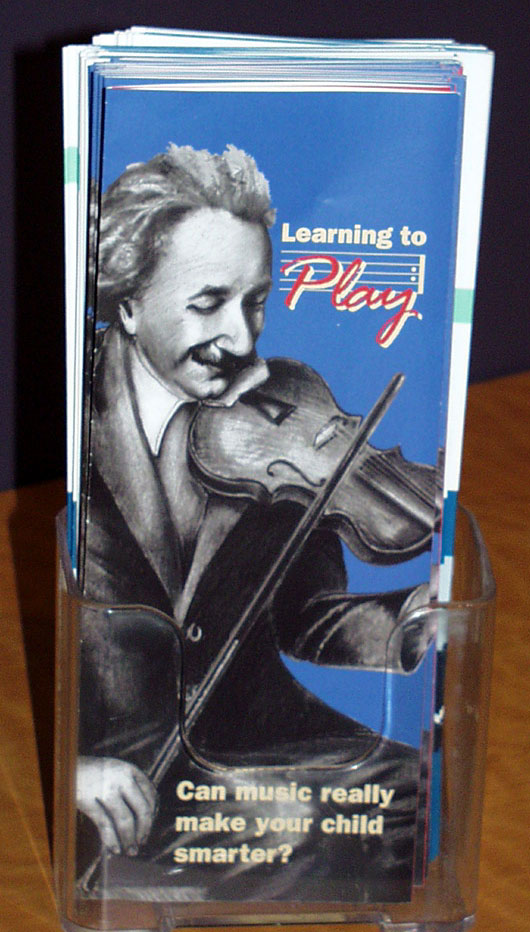 As
one exits the museum, there is a small shop with various kinds of gifts and
informational displays. The image of Albert Einstein playing a violin is
on one brochure, with the intriguing question "Can music really make your
child smarter?" Brochure readers are informed that "a rising
tide of research links music making to childhood brain development." They
are urged to enroll their children in a local school music programs. A
related exhibit, featuring Benny Goodman signing a placard in 1972 urging the
Chicago Board of Education to "save music schools" and
explaining "music is vital to growing up" provides visitors with
historical background: As
one exits the museum, there is a small shop with various kinds of gifts and
informational displays. The image of Albert Einstein playing a violin is
on one brochure, with the intriguing question "Can music really make your
child smarter?" Brochure readers are informed that "a rising
tide of research links music making to childhood brain development." They
are urged to enroll their children in a local school music programs. A
related exhibit, featuring Benny Goodman signing a placard in 1972 urging the
Chicago Board of Education to "save music schools" and
explaining "music is vital to growing up" provides visitors with
historical background:
Taxpayer revolts, budget cuts and decline in school
populations eliminated many music programs in the 1970s and 1980s. The music
industry worked to reverse the trend. The most dramatic battle was waged in
1972 to save music programs in the Chicago public schools. Spearheaded
by the American Music Conference (AMC), the effort involved a large coalition
of music related groups and well known musicians. Although successful in Chicago,
the industry watched helplessly as music programs vanished in dozens of cities
across America. To stem the tide, the AMC produced a tool kit called Support
School Music to help citizens campaign against budget cuts. Under
Vito Pascucci's leaderships and NAMM's , AMC also worked to garner federal
funding for school music...
Before you drive away from the museum at 5790 Armada Drive,
walk across the street to the promenade and take a look at Carlsbad's
colorful flower
fields pictured below. They will be music to your eyes!

Donald H. Harrison photos |


 Electro-Voice
Model V2 Microphone —In 1927 Al Kahn and Lew Burroughs opened a radio
service shop in South Bend, Indiana, and within a few years they developed a
public address system for Notre Dame football coach Knute Rockne so he could
communicate with his players from a tower overlooking the practice fields.
Rockne referred to the system as his electric-voice, which the company soon
adapted to electro-voice. Displayed is a velocity microphone that has a very
fragile ribbon of pure aluminum suspended inside a magnet assembly. The ribbon
responds to sound pressure changes and vibrates through the magnetic filed
creating a signal strong enough to drive a mixer input. First introduced by
RCA in the early 1930s ribbon microphones were popular in the broadcasting and
recording industries because of their warm, natural and smooth reproduction
qualities. This design has a bi-directional pick up pattern which means it is
sensitive to sound equally in front and back and it will almost completely
reject sound sources that lie perpendicular to it....
Electro-Voice
Model V2 Microphone —In 1927 Al Kahn and Lew Burroughs opened a radio
service shop in South Bend, Indiana, and within a few years they developed a
public address system for Notre Dame football coach Knute Rockne so he could
communicate with his players from a tower overlooking the practice fields.
Rockne referred to the system as his electric-voice, which the company soon
adapted to electro-voice. Displayed is a velocity microphone that has a very
fragile ribbon of pure aluminum suspended inside a magnet assembly. The ribbon
responds to sound pressure changes and vibrates through the magnetic filed
creating a signal strong enough to drive a mixer input. First introduced by
RCA in the early 1930s ribbon microphones were popular in the broadcasting and
recording industries because of their warm, natural and smooth reproduction
qualities. This design has a bi-directional pick up pattern which means it is
sensitive to sound equally in front and back and it will almost completely
reject sound sources that lie perpendicular to it.... On
the interactive display board, Goodman's King Porter Stomp is a
listening choice. Another, demonstrating the wide ranging interests of
Jewish composers, is an Irving Berlin song popularized by Bing Crosby.
You guessed it: White Christmas. Berlin is not the only Jew
whose name is associated with Christmas music. There is also on
display a Dinah Shore record album, obviously issued for the holidays.
Among Shore's selections: Jingle Bells, Silent Night and Santa
Claus. Berlin's music also was used in an album promoting the sale
of U.S. Savings Bonds during World War II
On
the interactive display board, Goodman's King Porter Stomp is a
listening choice. Another, demonstrating the wide ranging interests of
Jewish composers, is an Irving Berlin song popularized by Bing Crosby.
You guessed it: White Christmas. Berlin is not the only Jew
whose name is associated with Christmas music. There is also on
display a Dinah Shore record album, obviously issued for the holidays.
Among Shore's selections: Jingle Bells, Silent Night and Santa
Claus. Berlin's music also was used in an album promoting the sale
of U.S. Savings Bonds during World War II